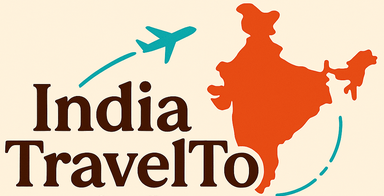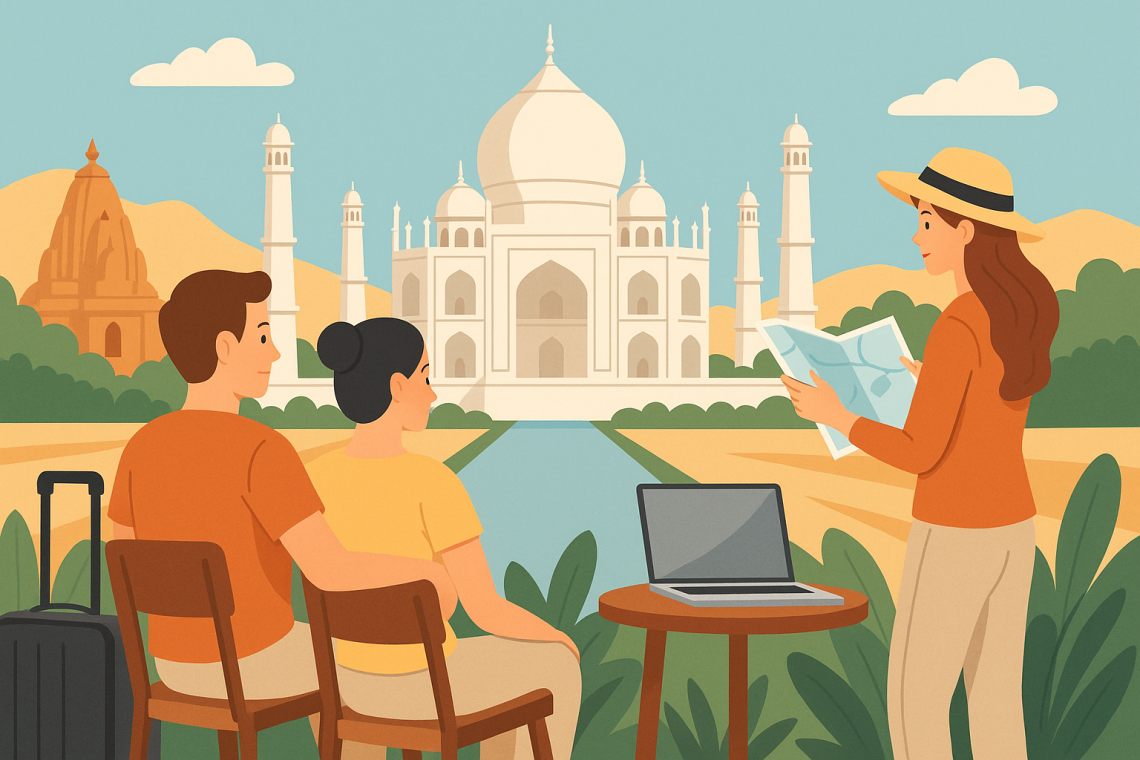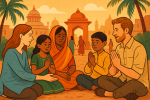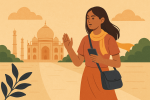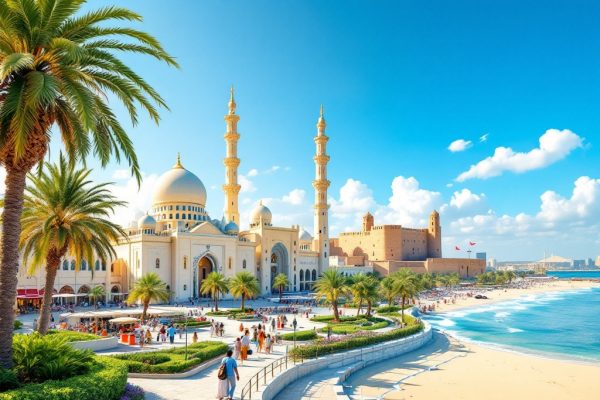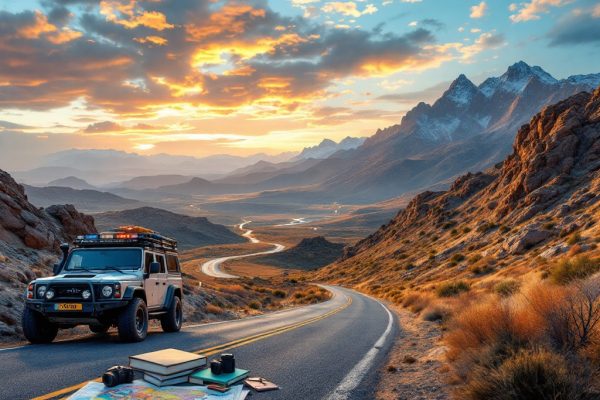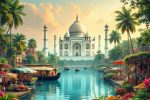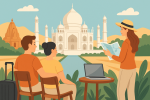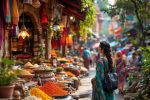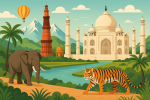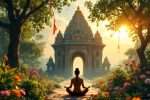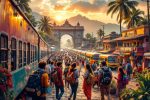How to Plan a Stress-Free Trip to India
Dreaming of an unforgettable Indian adventure? From the Himalayas to the beaches of Goa, India offers a diverse tapestry of experiences. This comprehensive guide provides expert tips on everything from visa requirements and packing essentials to cultural etiquette and health precautions, ensuring a smooth, stress-free trip. Discover how to plan your perfect itinerary, navigate local transportation, and stay safe while immersing yourself in India’s rich culture. Start planning your dream Indian getaway today!
Important information
- Plan your trip meticulously, especially during peak season (October to March). Book flights, accommodations, and transportation in advance to secure availability and better deals.
- India’s climate varies greatly. Research your destination’s weather and pack accordingly. Winter (October-February) generally offers the most pleasant temperatures for travel.
- Obtain a visa and ensure your passport is valid for at least six months beyond your return date. Secure comprehensive travel insurance covering medical emergencies and trip cancellations.
- Respect Indian customs. Dress modestly, especially at religious sites. Greet people with “Namaste” and avoid public displays of affection. Carry cash, especially for remote areas.
- Consume food and water safely. Eat freshly cooked dishes from reputable vendors and drink bottled or purified water. Avoid tap water, even for ice.
How to Plan a Stress-Free Trip to India
Planning your Indian adventure is exciting, but careful preparation is key to a smooth trip. Begin by defining your travel style. Do you prefer historical sites, bustling city life, tranquil beaches, or challenging mountain treks? Once you know your interests, research destinations that match them, considering the best time to visit each region due to weather and festivals. For example, exploring Rajasthan is ideal during the cooler months from October to March, while Kerala’s beauty thrives during the monsoon season between June and September.
Planning Your Trip
Meticulous planning ensures a stress-free trip. A well-structured itinerary helps save time, prevent unexpected issues, and secure flights, train tickets, and accommodations in advance—especially important during peak season. This guarantees availability and often leads to better deals. Prioritize pre-booking in busy cities like Delhi, Mumbai, and Jaipur. A detailed itinerary with daily activities helps balance exploration and relaxation, preventing a rushed experience. It also aids in budgeting and efficient packing.
Choosing Your Destination
India offers diverse experiences, making destination selection crucial. The Himalayas attract hikers, while Goa and Kerala boast stunning beaches. History enthusiasts will love Rajasthan’s majestic forts and Varanasi’s ancient streets. Consider your interests and travel style, research different regions, explore travel blogs, and consult travel agents to ensure your chosen destination meets your expectations.
Understanding India’s Climate
India’s diverse climate significantly impacts your travel experience. Summers (March to May) bring intense heat, especially in the north. Monsoons (June to September) bring heavy rainfall that can disrupt travel. Winters (October to February) offer the most pleasant weather, ideal for exploring. Research your destination’s climate to pack accordingly.
Packing Essentials
Pack light clothing for summer heat, but remember warm layers for winter chills. Don’t forget rain gear for the monsoon season. Comfortable walking shoes are essential for exploring various terrains.
Ensure a Hassle-Free Vacation: Importance of Proper Planning
Planning your vacation well is the key to a memorable trip. It helps you maximize your time and budget, allowing you to enjoy every moment. Here’s how to plan effectively:
Research your destination. Explore its attractions, local customs, and cultural nuances.
Create a flexible itinerary. Combine pre-booked accommodations and transport with room for spontaneous activities.
Consider pre-booking tours. This can often lead to cost savings.
This balance minimizes stress while allowing for unplanned adventures and discoveries. Thoughtful planning creates a more enjoyable and relaxing vacation.
Choose the Perfect Destination for Your India Trip
India, a land of diverse experiences, offers a destination for every traveler. Seeking tranquility and natural beauty? Explore the serene beaches of Goa, the lush backwaters of Kerala, or the breathtaking landscapes of Himachal Pradesh. For thrill-seekers, Uttarakhand and Leh-Ladakh present unforgettable adventures. History buffs and culture enthusiasts will discover rich treasures in Agra, Varanasi, and Jaipur. Beach lovers can find idyllic paradises in the Andaman & Nicobar Islands and Lakshadweep.
Ideal Seasons: Plan Your Trip According to Seasonal Variations
Planning your trip to India depends heavily on the diverse climate. Winter, from October to March, offers comfortable temperatures, ideal for exploring Rajasthan, Goa, and North India. If you prefer cooler temperatures during the summer months (April to June), the Himalayas provide a refreshing retreat. The monsoon season (June to September) offers travel bargains in Kerala and Goa, but be prepared for potential heavy rainfall and possible flooding in certain coastal areas. Booking in advance is highly recommended, especially during the peak season (October to March), to avoid inflated prices and secure your preferred accommodations.
When to Visit India
- Winter (October-March): Pleasant weather, perfect for exploring Rajasthan, Goa, and North India.
- Summer (April-June): Cooler temperatures in the Himalayas offer a refreshing escape.
- Monsoon (June-September): Travel bargains in Kerala and Goa, but be mindful of potential heavy rainfall.
Booking Tips
Book in advance, especially during the peak season (October to March), to avoid higher prices and secure your accommodations.
Travel Arrangements and Preparations
Planning your trip to India? Here’s what you need to know:
Documentation and Insurance
ensure your passport is valid for at least six months beyond your planned return date. Secure the necessary visa based on your nationality and purpose of visit. obtain comprehensive travel insurance that covers medical emergencies, trip cancellations, and lost baggage, for a worry-free experience.
Flights and Accommodation
Book your flights and accommodations well in advance, especially if traveling during peak season or to popular destinations. Consider your budget and preferred travel style when choosing accommodations, ranging from budget-friendly hostels to luxurious hotels. explore various booking platforms and compare prices to find the best deals.
Getting Around India
Domestic flights are a convenient option for traveling between major cities. Trains offer a scenic and immersive experience, allowing you to witness the diverse landscapes of India. For maximum flexibility and personalized itineraries, consider hiring a car and driver. Within cities, utilize ride-sharing apps or local taxis for convenient and affordable transportation.
Staying Connected
Purchase a local SIM card upon arrival at the airport or from authorized stores for affordable calls, texts, and internet access. Alternatively, activate an international roaming plan with your current mobile provider before your trip. Compare the costs and benefits of both options to choose the best solution for your communication needs.
Essential Travel Documents and Insurance
Ensure your passport’s validity extends at least six months beyond your return date.
Most nationalities require a visa, so apply well in advance.
Secure travel insurance to cover unforeseen circumstances like medical emergencies and trip cancellations.
Consider any specific needs or requirements for your particular trip.
Booking Flights and Accommodation in India
Secure your flights and accommodations early, ideally as soon as your travel dates are set. This will help you snag the best deals and maximize your options, particularly during peak seasons.
Utilize reputable booking platforms. Compare prices and tailor your choices to your budget and preferences.
This forward-thinking approach minimizes last-minute hassles, ensuring a smoother, more enjoyable trip.
Transportation Within India: Navigating Local Options
Traveling within India offers diverse options depending on your needs. For longer journeys, domestic flights are a fast and convenient choice. Trains provide a scenic and budget-friendly alternative, allowing you to experience the beauty of the Indian landscape. Hiring a car and driver offers comfortable and personalized travel, catering to your specific itinerary. For shorter trips within cities, various options are available. Ride-sharing apps and taxis are readily accessible and offer convenient point-to-point travel. Many tourist areas have cost-effective public transport, including metro passes, travel cards, and bus passes, ideal for exploring cities affordably. Renting a car and driving yourself is possible, but ensure you possess the necessary documentation, such as an international driving permit.
Long-Distance Travel
- Domestic Flights: A fast and convenient option for covering long distances.
- Trains: A scenic and budget-friendly way to travel and enjoy the Indian countryside.
- Car and Driver: Personalized and comfortable travel experience tailored to your itinerary.
Short-Distance Travel (Within Cities)
- Ride-sharing Apps/Taxis: Easy and convenient for point-to-point travel.
- Public Transport: Cost-effective options like metro passes, travel cards, and bus passes are great for city exploration.
- Self-Drive Car Rentals: Possible with the required documentation, such as an international driving permit.
With a little planning, navigating India’s diverse transport system is straightforward.
Stay Connected: Get a Local SIM Card
Planning a trip to India? A local SIM card is a must-have for seamless access to essential travel services. Stay connected with transportation apps, navigate with ease, and enjoy convenient food delivery. A local SIM offers a budget-friendly way to keep in touch with family and friends back home, plus ensures uninterrupted access to online banking and other important online services. Simplify your Indian adventure and stay connected with a local SIM card.
Budgeting and Financial Planning for Your India Trip
Planning a trip to India? A well-structured budget is key for a smooth and enjoyable experience. Consider these essential aspects: transportation, accommodation, food, and activities. India caters to all budgets, from budget-friendly hostels to luxurious resorts. Setting daily spending limits can be particularly helpful. This is especially true for road trips, where you’ll need to factor in fuel, food, and lodging.
Money Matters
Travel cards can offer discounts on accommodations and dining. However, carrying local cash is wise, especially in remote areas.
Payment Methods
Major cities offer ATMs. Digital payment methods like UPI and mobile wallets are also prevalent.
For currency exchange, consider exchanging some in advance. Using ATMs upon arrival offers more flexibility.
Exchange Currency at Authorized Centres
Exchange currency at banks, airports, or reputable exchange bureaus. Obtain a receipt and verify the exchange rate and the amount received for your security.
Leveraging Travel Cards and Discounts
Travel cards offer excellent perks, such as exclusive discounts for hotels and dining. Prepaid options are a smart budgeting tool, allowing you to load a fixed amount and avoid overspending. However, it’s crucial to compare cards carefully. Opt for one with no foreign transaction fees to save money abroad and prioritize robust security features to protect your finances and personal data. The right travel card offers both convenience and control, maximizing your travel benefits.
Benefits of Travel Cards
- exclusive discounts for hotels and dining,
- prepaid options for budgeting and avoiding overspending,
- potential for no foreign transaction fees,
- robust security features for financial and personal data protection.
Choosing the Right Card
Compare cards carefully to find one that aligns with your spending habits and travel needs. Look for features like no foreign transaction fees to maximize savings abroad. Prioritize robust security features to safeguard your financial and personal information.
Managing Cash Transactions in Remote Areas
Cash is king in remote areas of India, where ATMs are scarce. Local businesses primarily operate on a cash basis, so carrying sufficient funds is crucial for seamless transactions. Credit and debit cards are often not accepted.
Packing and Personal Preparation
Planning a trip to India? Smart packing is crucial. Consider these essential categories: clothing, toiletries, electronics, and documents. Due to India’s diverse climate, pack versatile items. Lightweight clothing is ideal for warmer regions, while a light jacket is useful in cooler areas. Comfortable shoes are essential for exploring. Don’t forget necessary medications and a basic first-aid kit. Hand sanitizer and wet wipes will be invaluable. Keep your passport and visa accessible and secure. Remember chargers and adapters for your electronic devices.
Health Essentials for Your Trip
Prioritizing your health is key while traveling. Pack a compact first-aid kit containing bandages, antiseptic wipes, and pain relievers. Hand sanitizer is crucial, especially when soap and water are unavailable. Wet wipes are handy for quick cleaning. Don’t forget insect repellent, particularly if traveling during mosquito season.
Staying Hydrated and Prepared
A reusable water bottle is both eco-friendly and essential for staying hydrated. Ensure any prescription medications are clearly labeled and easily accessible. Travel insurance is a wise investment for unforeseen medical expenses. A small flashlight can also be surprisingly useful in various situations.
Efficient Packing: Creating a Comprehensive Checklist
Categorize your packing list into clothing, toiletries, electronics, medications, and documents for easy organization.
Under each category, specify what you’ll need. For instance, under “clothing,” include “shirts,” “pants,” and “shoes“.
Consider the weather and your planned activities to pack appropriate attire.
Review your airline’s baggage allowances to avoid extra fees.
Personal Sanitization and Health Essentials
For healthy travels, pack the following items:
- hand sanitizer,
- antibacterial wipes,
- tissues.
A well-stocked first-aid kit is also crucial. Pack these items in your kit:
- bandages,
- antiseptic cream,
- any personal medications.
Don’t forget mosquito repellent and sunscreen. If motion sickness is a concern, pack appropriate remedies.
Health and Safety Tips for Travelers
Consult your doctor.
Before traveling to India, consult your doctor to discuss recommended vaccinations, such as typhoid, hepatitis A and B, and any necessary medications. Carry a valid Yellow Fever Vaccination Certificate if required.
Choose your food carefully.
When enjoying India’s vibrant street food scene, select freshly cooked dishes from reputable vendors. Avoid raw or undercooked meat, seafood, and unpasteurized dairy. Opt for peeled fruits and vegetables.
Drink safe water.
Stick to bottled or purified water, avoiding tap water even for ice cubes. Use bottled water for brushing your teeth as well.
Protect your belongings.
Be vigilant about pickpockets and scams, particularly in crowded areas. Secure your belongings and be wary of common scams. Avoid displaying large amounts of cash.
Stay safe at night.
Refrain from walking alone at night, especially in poorly lit areas. Use reliable transportation and inform someone of your whereabouts.
Check air quality.
Check air quality forecasts, as pollution can be a concern. Consider wearing a mask, especially in polluted cities, and limit outdoor activities during peak pollution times.
Take precautions at high altitudes.
If your travels include high altitudes, acclimatize gradually. Stay hydrated and avoid strenuous activity initially. Consult a doctor if you experience altitude sickness.
Health Vaccines and Medications Before Traveling
Before your trip to India, consult your doctor about recommended vaccinations, such as typhoid, hepatitis A, and hepatitis B. Ensure your routine immunizations are up-to-date. Travelers from yellow fever-endemic countries must carry a Yellow Fever Vaccination Certificate. Remember to pack any prescribed medications and a basic first-aid kit for common ailments. With a little preparation, you can enjoy a healthy and worry-free trip!
Food Safety: Enjoying Street Food Without Worry
Observe food preparation practices.
Select vendors with pristine stalls and vibrant, fresh ingredients.
A bustling stall often indicates high turnover, ensuring your meal is freshly cooked. However, steer clear of raw or undercooked dishes like salads and chutneys, as these pose a greater risk.
Keep hand sanitizer handy and use it before and after your meal.
Consult local recommendations and online reviews for guidance on safe and delicious street food options.
Water Safety: Avoiding Unfiltered Tap Water
For your health’s sake, avoid India’s tap water, as it can cause illness. Opt for bottled water instead, especially recognizable brands readily available throughout the country.
Pickpocketing and Scams Awareness
When in crowded areas, stay vigilant and keep a close eye on your belongings. Be wary of unsolicited offers and avoid scams. If something sounds too good to be true, it probably is. Consult official sources for reliable information to stay informed and protect yourself.
Night Safety: Staying Aware of Surroundings
For your safety, stick to well-lit and populated areas, especially at night.
Whenever possible, travel with friends or use reliable transportation.
Avoid isolated spots, particularly when alone after dark.
Air Pollution Precautions
In cities, using a good pollution mask offers valuable protection. Keep essential medications handy. By checking air quality reports, you can effectively plan outdoor activities to ensure your safety.
Handling Altitude Sickness in High Regions
Ascend gradually to help your body acclimatize to the altitude.
Hydration is crucial, so drink plenty of water.
Initially, abstain from alcohol and strenuous exercise, as these can exacerbate altitude sickness.
Pay attention to your body. If you feel unwell, descend to a lower altitude.
Should symptoms persist, seek immediate medical attention.
Understanding Indian Culture and Etiquette
Greet with a warm “Namaste”.
Avoid public displays of affection.
Remove your shoes before entering homes or sacred places.
Dress modestly, particularly at religious sites.
Learn basic Hindi phrases.
Bargain respectfully in markets.
Avoid littering.
Ask permission before taking photos.
Master Indian Etiquette: Greetings and Gestures
Traveling to India? Observe these cultural etiquettes:
Greet with “Namaste”: Offer a respectful “Namaste” with palms together and a slight bow.
Be mindful of your feet: Avoid pointing your feet at people or sacred objects.
Respect personal space: Public displays of affection are generally frowned upon.
Remove your shoes: Remember to remove your shoes before entering homes or religious sites.
Use your right hand: Use your right hand for eating, giving, or receiving items.
Dress modestly: Modest dress is appreciated, especially in religious places.
Ask before photographing: Always ask permission before taking someone’s photograph.
Bargain respectfully: Bargaining is expected in markets, but do so respectfully.
Learn basic Hindi: Learning a few basic Hindi phrases, such as “shukriya” (thank you), will enhance your interactions.
Dress Guidelines: Attentive to Local Traditions
When visiting India, show cultural sensitivity by dressing respectfully in modest clothing, particularly at religious sites. Avoid revealing attire in more conservative areas. Researching regional customs not only improves your trip but also demonstrates respect and enhances your understanding of local traditions. Here’s a guide to help you:
Dress modestly, especially at religious sites. Covering your shoulders and knees is often expected. Avoid tight or see-through clothing.
Be mindful of regional customs. India is diverse, so what’s acceptable in one area might not be in another. Researching local traditions beforehand shows respect.
Learn basic greetings and phrases. Even a few words in the local language can go a long way in building rapport and showing your appreciation for the culture.
Religious Etiquette at Sacred Sites
When visiting sacred spaces, dress respectfully, ensuring your shoulders and knees are covered. Remember to remove your shoes before entering temples, mosques, or similar sites. Maintain a quiet demeanor and avoid disruptive actions. Photography may be restricted, so heed posted signage. Public displays of affection are generally discouraged. Be observant of local traditions; some temples prohibit leather goods, while others may require women to cover their heads. Always seek permission before photographing ceremonies or individuals. A small donation is often a welcome gesture of respect.
Bargaining Tips for Travelers
Haggling is a common practice in Indian street markets. Be respectful when negotiating, as vendors anticipate it. If a price can’t be reached, politely decline and depart amicably.
